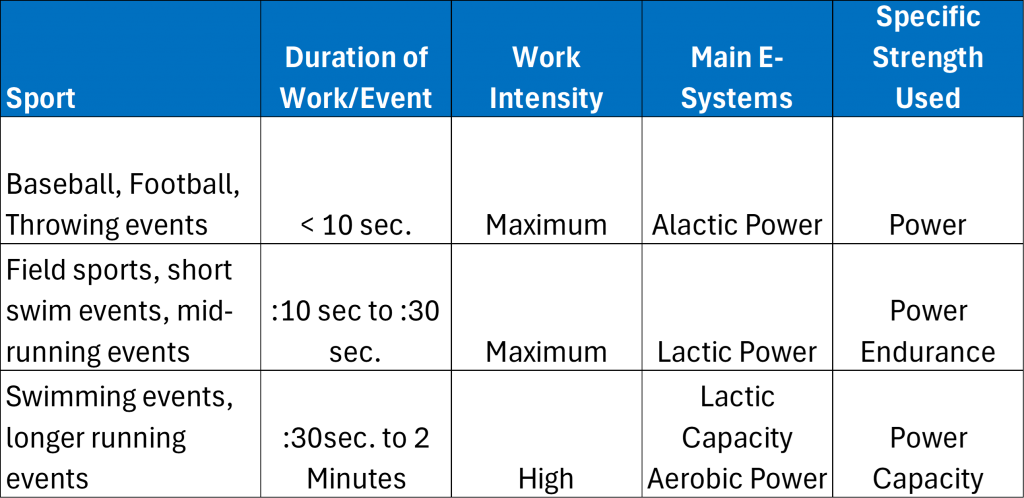
I love to use the phrase, “training doesn’t happen in isolation”. In other words, there’s a time to train strength and a time to learn to apply that strength quickly. Post-activation potentiation (referred to from here on out as “PAP”) is a phase we use once harder throwing begins at the mid-point of the off-season with our more advanced athletes to train explosive power.
What exactly is PAP?
PAP is a combination training method that combines an initial heavy set of an exercise to “activate” specific muscles followed by a similar exercise with a much lighter load to “potentiate” the same muscles. This helps Improve the maximum amount of muscle recruitment (CNS), as well as helping to develop the nervous system’s ability to improve explosive ability.
Heavy Set – Activation
Lighter Set – Potentiation
Power = Force X Velocity
The elastic properties of muscles favor both the absorption and reuse of stored elastic energy, which is optimized when a muscle is lengthened as quickly as possible. Therefore, to improve Force expression of the full spectrum of Velocity and increase the rate of Power (force development), both heavy loads and light loads are necessary in training.
So let’s breakdown both sides of the PAP equation, Activation and Potentiation one at a time.
Activation
First let’s define muscle “activation”. Muscle activation is the process of contracting a muscle through nerve stimulation. This is where the initial “heavier” lifting comes into play, stimulating the muscle fibers and causing them to contract and generate force.
In a PAP program, we generally prescribe:
-
- Sets: 3
- Reps: 3
- Load / intensity: 85-87% (.40-.48 m/s if using VBT)
- Rest: 2-3 min between heavy sets
These heavy sets will stimulate the nervous system and allow for greater activation in the explosive exercise that follows. Performing these heavy lifts only 1-2x’s / week will also help maintain strength gains from earlier off-season training.
Trap Bar Deadlift at 80-90% 1RM
“Heavy lifting stimulates the muscle fibers causing them to contract and generate force.”
Potentiation
The next “lighter” set is generally performed approx. 1-2 minutes after the heavier “activation” set. This is done primarily by progressing to training power with one of the three fundamental options that is dominant in your sport. These would be either:
-
- Alactic Power (max effort for < :10 sec)
- Lactic Power (10 sec – :30 sec)
- Aerobic Power (30 sec – 2min.)
As stated above, the type of power we choose to train relies mostly on the sport we are training for. The chart below shows the primary power requirements for different sports based off of the energy systems (work/rest) used in competition for that sport.

“Specific strength needs based off of duration of events”
We can see that baseball relies primarily on the ability to produce alactic power by utilizing the “alactic system”. Improving this system requires:
-
- Increasing the Rate of enzyme production – This helps speed up the breakdown of phosphocreatine and enabling the body to create ATP at a rapid rate.
- Muscular Contractility (RFD) – How fast your fast twitch muscle fiber can contract plays a large role in how much power you can generate with the Alactic system.
This is where the potentiation side of the equation comes in. Muscle potentiation is defined as “the increase in a muscle’s contractile performance after a previous contraction” (activation). Thus, the term “post activation/ potentiation”
We generally prescribe:
-
- Sets: 3
- Reps: 6-8 reps or 7-10 sec
- Load/Intensity: BW- 30% 1RM (1.0-1.2 m/s if using VBT)
- Rest: 1-2 Min
Trap Bar Jumps @ 20%
“Using more ballistic movements to potentiate the muscles post-activation”
Summary
Post activation Potentiation (PAP), is a training method where a set using heavier loads (85-87% 1RM) is used to “activate” the muscles and is followed by a lighter set (BW- 30% 1RM) to potentiate. By utilizing an exercise that recruits the same muscles as the previous heavy set, We can get a training adaptation that not only trains explosive power but helps the athlete maintain the strength built up from prior strength phases.
It also works great when heavier throwing begins due to the high intensity but lower overall volume.
See ya’ in the gym…
By Nunzio Signore (BA, CSCS, CPT, NASM, FMS)
If you’d like to be placed on our email list please enter your email address below!
